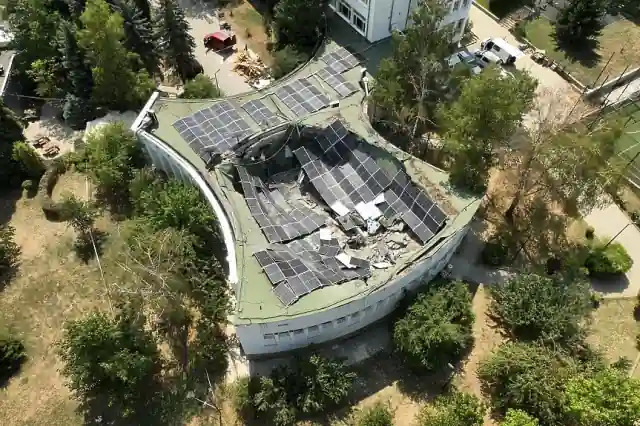
Sofia, Bulgaria — A roof collapse at the New Bulgarian University (NBU) has left one worker with severe internal injuries, while five others narrowly escaped the accident.
The incident occurred when a section of the roof, including photovoltaic panels, gave way, trapping the worker underneath. The injured man, whose condition remains serious, is undergoing a series of operations at “Pirogov” Hospital.
Accident Details and Rescue Efforts
The collapse, which happened earlier today, saw a significant portion of the roof and associated photovoltaic panels fall onto the construction site.
The trapped worker, identified only as a construction laborer, was found conscious but trapped from the waist down. Rescue teams faced the challenging task of clearing debris to reach the injured man.
Senior Inspector Plamen Radev of the Metropolitan Fire Department detailed the meticulous rescue operation. The rescue teams first removed the photovoltaic panels before addressing the heavier debris.
“We had to be extremely careful to avoid causing further harm,” Radev said. “The operation was complex due to the weight of the materials and the precarious position of the trapped worker.”
A rescue dog, trained as part of a fire department program initiated after the earthquake in Turkey, played a crucial role in the operation.
The canine, skilled in locating survivors through scent, assisted the teams in ensuring no additional workers were trapped beneath the debris.
Initial Investigations and Municipal Response
Following the collapse, two teams from the “Emergency Assistance and Prevention” Directorate of the Metropolitan Municipality were dispatched to the scene.
An initial inspection by the municipality suggested that the incident might have involved human error.
Krasimir Dimitrov, director of the “Emergency Assistance and Prevention” Directorate, indicated that mistakes in demolition technology could have contributed to the collapse.
“Such accidents often occur when the demolition work is not properly planned or executed, particularly if the structure was not adequately stabilized before work began,” Dimitrov explained. He confirmed that the photovoltaic panels had been in place prior to the collapse.
The Directorate for National Construction Control (DNCC) conducted an inspection and found that the collapse was neither accidental nor a result of illegal construction practices.
This assessment is crucial as it clarifies that the incident did not stem from unapproved construction activities.
In response to the incident, Mayor Vasil Terziev has ordered a comprehensive review of all roof structures across municipal schools, kindergartens, hospitals, and sites with photovoltaic installations.
This precautionary measure aims to ensure the safety and stability of similar structures throughout the city.
The Aftermath and Safety Measures
The injured worker’s condition remains critical, with multiple internal injuries requiring extensive medical intervention. The focus now shifts to his recovery and the implications of the incident for construction safety protocols.
Local authorities and construction safety experts are closely examining the circumstances surrounding the collapse to prevent future occurrences.
The incident has highlighted the importance of stringent safety measures in construction and renovation projects, especially when dealing with structural modifications and the installation of photovoltaic systems.
The New Bulgarian University community, along with the broader public, is awaiting further updates on the injured worker’s condition and the results of ongoing safety reviews.
The accident has underscored the need for enhanced safety procedures and rigorous inspections to protect workers and ensure the integrity of construction projects.
As investigations continue, the focus remains on addressing the immediate needs of the injured worker and implementing preventive measures to avoid similar incidents in the future.
The response from municipal authorities and construction oversight bodies will play a critical role in ensuring the safety and well-being of all those involved in such high-risk environments.
